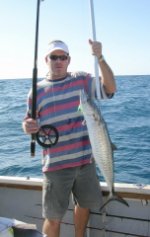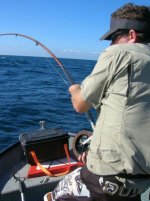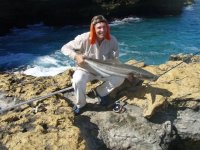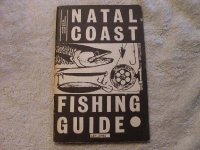Nice fish tintin - dammn strong, I caught a cobia with a 5" KP off a boat and it took me an embarrasingly long time to land!!
@ Skollie - what BigMatt is referring to as a 'floppier' rod is best for 'whipping' couta spoons - if you look at the rod in the second pic you will notice how it bends all the way to the butt,(Its caught a lot of fish but like so many things in SA went 'missing') when 'whipping' you need to work up a rhythm, some guys can do it for hours and often bring the fish up to your baits. Mozambique is a great place to spoon because shoal couta are plentiful and you get lots of hits and can have some fun even though the fish are darts in the 3-7kg range you can fish light but I generally stick to 20lb on the 5" and 25lb on the 6".
In Mozambique I use a 4" spoon (sometimes dressed with a cuda duster) or a Spro bucktailjig and in Natal the guys generally use 5" or 6" couta spoons, I have seen guys on the South Coast use 7" spoons on 7/8" KP's and get some big fish!! (vertical jigging ha ha!)(Iwill try and post some spoon pics)
I am not too good at the 'cowboy' or 'sezela' and can do it ok but a mate of mine can do it amongst aerials/rods/people on the boat and still get 50-60 meters accurately - in fact I have seen him 'convert' a 3oz sinker 6 times out of 10 over rugby posts from half way and the 4 misses are all close!!
Sadly 'wagonwheel' fishing is dying out, less and less Indian fishermen use them on the beaches (ballraces) and with modern spinning reels around less lighties are learning to use them on the old mans boats, some guys even bottom fish with grinders.......WHY!! You cannot beat the simplicity of a scarborough, for me there is no better way of catching couta - your brain is connected directly to the fish, your hand is the drag and the gear 1:1 - EXCELLENT!!!
By the way the All Africa Striped Marlin record of 92kgs was caught on a.............6"KP!!!! (30lb mono with a live mozzie)




